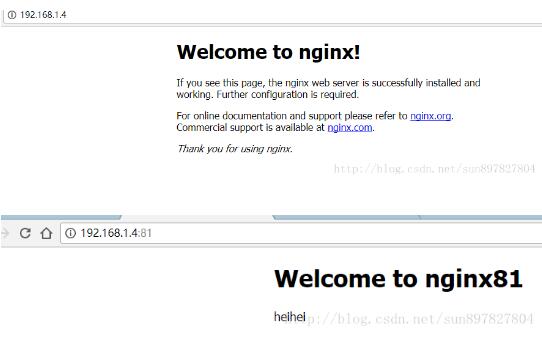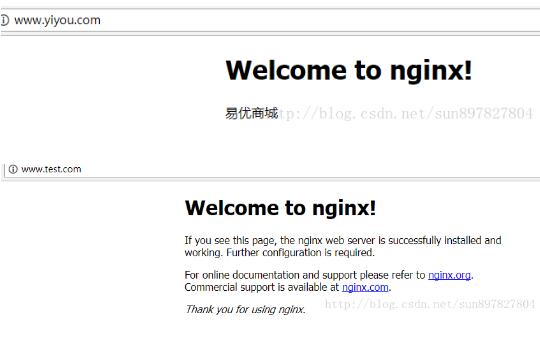How does nginx enable one server to access multiple websites?
On a server, accessing different websites
There are usually two ways to distinguish:
1. Through the listening port number
2. Through the domain name
1. Access different hosts through the port:
nginx configuration file:
/usr/local/nginx/ conf/nginx.conf
centos file default encoding format latin1
Command to view the encoding format: :set fileencoding
#user nobody;
worker_processes 1;
#error_log logs/error.log;
#error_log logs/error.log notice;
#error_log logs/error.log info;
#pid logs/nginx.pid;
events {
worker_connections 1024;
}
##一个http节点
http {
include mime.types;
default_type application/octet-stream;
#log_format main '$remote_addr - $remote_user [$time_local] "$request" '
# '$status $body_bytes_sent "$http_referer" '
# '"$http_user_agent" "$http_x_forwarded_for"';
#access_log logs/access.log main;
sendfile on;
#tcp_nopush on;
#keepalive_timeout 0;
keepalive_timeout 65;
#gzip on;
#server 节点,即 你需要访问网站的配置
#一个server节点,就是一个虚拟主机
server {
listen 80; #监听的端口号,访问网站 默认是80端口
server_name localhost; #即访问的域名
#charset koi8-r;
#access_log logs/host.access.log main;
location / { #定位
root html; #定位的是nginx根目录下的 html文件夹
index index.html index.htm; #设置网站首页
}
}
}At this time, multiple servers can be configured, that is, configuration Different hosts
Add virtual host: (difference by port number)
server {
listen 81;
server_name localhost;
#charset koi8-r;
#access_log logs/host.access.log main;
location / {
root html-81;
#nginx根目录下 新建的html81 文件夹
index index.html index.htm;
``
}After editing the file, we reload the configuration file
Use the command: ./nginx - s reload
Effect:

We know that when multiple websites are configured on a server, it is impossible to distinguish them by port number, so then Next, I need to distinguish by domain name
2. Distinguish different virtual hosts by domain name
What is a domain name? ?
The domain name is the website address
For example: www.baidu.com
Usually when we access the domain name, we need to resolve the domain name through the dns server
dns Server: resolve domain name to IP address. What is saved is the mapping relationship between domain name and IP.
A domain name corresponds to an IP address, and an IP address can be bound to multiple domain names.
Local testing can modify the hosts file.
Modify the hosts file of window: (c:\windows\system32\drivers\etc)
You can configure the mapping relationship between domain name and ip. If the mapping relationship between domain name and ip is configured in the hosts file, No need to use dns server! ! ! !
Continue to configure under the nginx.conf file just now:
server {
listen 80;
server_name www.taobao.com;
#charset koi8-r;
#access_log logs/host.access.log main;
location / {
root html-taobao;
index index.html index.htm;
}
}
server {
listen 80;
server_name www.baidu.com;
#charset koi8-r;
#access_log logs/host.access.log main;
location / {
root html-baidu;
index index.html index.htm;
}
}
}Domain name configuration:
192.168.25.148 www .test.com
192.168.25.148 www.yiyou.com
Restart nginx service
Observe the effect:

The above is the detailed content of How does nginx enable one server to access multiple websites?. For more information, please follow other related articles on the PHP Chinese website!

Hot AI Tools

Undresser.AI Undress
AI-powered app for creating realistic nude photos

AI Clothes Remover
Online AI tool for removing clothes from photos.

Undress AI Tool
Undress images for free

Clothoff.io
AI clothes remover

Video Face Swap
Swap faces in any video effortlessly with our completely free AI face swap tool!

Hot Article

Hot Tools

Notepad++7.3.1
Easy-to-use and free code editor

SublimeText3 Chinese version
Chinese version, very easy to use

Zend Studio 13.0.1
Powerful PHP integrated development environment

Dreamweaver CS6
Visual web development tools

SublimeText3 Mac version
God-level code editing software (SublimeText3)

Hot Topics
 1655
1655
 14
14
 1413
1413
 52
52
 1306
1306
 25
25
 1252
1252
 29
29
 1226
1226
 24
24
 How to configure nginx in Windows
Apr 14, 2025 pm 12:57 PM
How to configure nginx in Windows
Apr 14, 2025 pm 12:57 PM
How to configure Nginx in Windows? Install Nginx and create a virtual host configuration. Modify the main configuration file and include the virtual host configuration. Start or reload Nginx. Test the configuration and view the website. Selectively enable SSL and configure SSL certificates. Selectively set the firewall to allow port 80 and 443 traffic.
 How to check the name of the docker container
Apr 15, 2025 pm 12:21 PM
How to check the name of the docker container
Apr 15, 2025 pm 12:21 PM
You can query the Docker container name by following the steps: List all containers (docker ps). Filter the container list (using the grep command). Gets the container name (located in the "NAMES" column).
 How to start containers by docker
Apr 15, 2025 pm 12:27 PM
How to start containers by docker
Apr 15, 2025 pm 12:27 PM
Docker container startup steps: Pull the container image: Run "docker pull [mirror name]". Create a container: Use "docker create [options] [mirror name] [commands and parameters]". Start the container: Execute "docker start [Container name or ID]". Check container status: Verify that the container is running with "docker ps".
 How to check whether nginx is started
Apr 14, 2025 pm 01:03 PM
How to check whether nginx is started
Apr 14, 2025 pm 01:03 PM
How to confirm whether Nginx is started: 1. Use the command line: systemctl status nginx (Linux/Unix), netstat -ano | findstr 80 (Windows); 2. Check whether port 80 is open; 3. Check the Nginx startup message in the system log; 4. Use third-party tools, such as Nagios, Zabbix, and Icinga.
 How to create containers for docker
Apr 15, 2025 pm 12:18 PM
How to create containers for docker
Apr 15, 2025 pm 12:18 PM
Create a container in Docker: 1. Pull the image: docker pull [mirror name] 2. Create a container: docker run [Options] [mirror name] [Command] 3. Start the container: docker start [Container name]
 How to check nginx version
Apr 14, 2025 am 11:57 AM
How to check nginx version
Apr 14, 2025 am 11:57 AM
The methods that can query the Nginx version are: use the nginx -v command; view the version directive in the nginx.conf file; open the Nginx error page and view the page title.
 How to configure cloud server domain name in nginx
Apr 14, 2025 pm 12:18 PM
How to configure cloud server domain name in nginx
Apr 14, 2025 pm 12:18 PM
How to configure an Nginx domain name on a cloud server: Create an A record pointing to the public IP address of the cloud server. Add virtual host blocks in the Nginx configuration file, specifying the listening port, domain name, and website root directory. Restart Nginx to apply the changes. Access the domain name test configuration. Other notes: Install the SSL certificate to enable HTTPS, ensure that the firewall allows port 80 traffic, and wait for DNS resolution to take effect.
 What to do if nginx server is hung
Apr 14, 2025 am 11:42 AM
What to do if nginx server is hung
Apr 14, 2025 am 11:42 AM
When the Nginx server goes down, you can perform the following troubleshooting steps: Check that the nginx process is running. View the error log for error messages. Check the syntax of nginx configuration. Make sure nginx has the permissions you need to access the file. Check file descriptor to open limits. Confirm that nginx is listening on the correct port. Add firewall rules to allow nginx traffic. Check reverse proxy settings, including backend server availability. For further assistance, please contact technical support.




